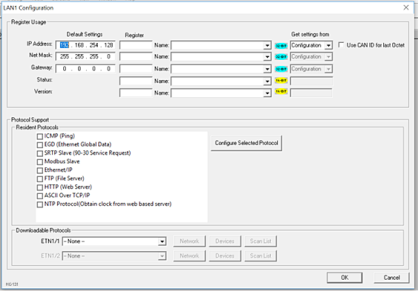SRTP - Service Request Transfer Protocol
See also: Ethernet Configuration Overview
Topic Menu
SRTP Overview
Service Request Transfer Protocol (SRTP) is a GE Fanuc Automation protocol, which allows a remote SRTP Client to request services from an SRTP Server. In this context, the OCS acts as an SRTP Server, which responds to requests from one or more SRTP Clients. Since SRTP was originally designed to support services provided by GE Fanuc Series 90 PLC products, the OCS’s SRTP protocol, for OCS and RCS products, does not support all possible SRTP services. The OCS’s implementation of SRTP is mainly limited to those services required for the exchange of PLC register data.
Note: This is a Built-In (Resident) Industrial Protocol.
The following SRTP service requests are supported:
| SRTP Service Requests | |
|---|---|
| Request Code | Service Name |
| 0 | PLC_SSTAT |
| 1 | PLC_LSTAT |
| 4 | READ_SMEM |
| 7 | WRITE_SMEM |
| 33 | CHG_PRIV_LEVEL |
| 67 | RET_CONFIG_INFO |
| 79 | SESSION_CONTROL |
| 97 | PLC_FEATURES_SUPP |
The READ_SMEM and WRITE_SMEM requests are supported for the following register types:
| SRTP Register Types | ||
|---|---|---|
| Selector | Register | Type |
| 8 | %R |
16 bit |
| 10 | %AI |
16 bit |
| 12 | %AQ |
16 bit |
| 16 | %I |
8 bit |
| 18 | %Q |
8 bit |
| 20 | %T |
8 bit |
| 22 | %M |
8 bit |
| 30 | %S |
8 bit |
| 70 | %I | 1 bit |
| 72 | %Q | 1 bit |
| 74 | %T | 1 bit |
| 76 | %M | 1 bit |
| 84 | %S | 1 bit |
Return to the Top: SRTP - Service Request Transfer Protocol
SRTP Configuration
If SRTP protocol will be used in the application, the general OCS Configuration, previously described in the [General Configuration Chapter], must be performed, and SRTP must be enabled. To enable SRTP protocol, use Cscape Programming Software, to perform the following two steps:
-
Open the OCS configuration dialog (Home > Controller > Hardware Configuration > LAN1 / Config) as described in Ethernet Configuration Overview
-
Enable SRTP by checking the SRTP Slave (90-30 Service Request) checkbox in the Module Configuration dialog, see below.
No additional configuration is required for SRTP protocol, so the Configure Selected Protocol button is disabled. If SRTP is enabled and the OCS has been assigned an IP Address and Net Mask, then it will respond to service requests from an SRTP Client.
SRTP Operation
With respect to SRTP protocol, the OCS’s behavior depends on whether the OCS is in RUN mode or not.
-
When the OCS is in RUN mode, the OCS responds normally to SRTP Client requests.
-
When the OCS is not in RUN mode, it still responds to SRTP Client requests, with the following differences:
-
When a WRITE_SMEM request is received from an SRTP Client, to write a block of OCS registers, a reply is sent to the client, but the data is not written to OCS registers.
-
When a READ_SMEM request is received from an SRTP Client, to read a block of OCS registers, a reply is sent to the client, but the data returned to the client is the last known values of the requested OCS registers, and is not actually read from the OCS registers.
-
For all requests received from an SRTP Client, the reply will indicate to the client that the OCS is not in RUN mode, by returning the RUN DISABLED code in the Piggyback Status word.
-
Return to the Top: SRTP - Service Request Transfer Protocol
